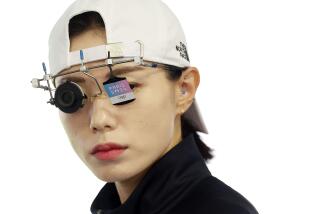Move Over, Annie Oakley : At 14, Arroyo High’s Kimberly Rhode Already Commands Respect From Adult Skeet Shooters--Despite Her Patriotically Painted Braces
- Share via
A tiny girl. Blond hair. Cute smile. Braces on her teeth. Kimberly Rhode is so . . . so disarming.
In another era, with fewer principles, she and her father, Richard, would have done well traveling the Wild West and playing the suckers for whatever they were worth.
Too late now. At 14 and only a freshman at Arroyo High School in El Monte, she has been a cover girl for Skeet magazine and is so well known among U.S. competitive shooters that whenever she shows up, all of the women--and most of the men--know they will be shooting for second place.
Fortunately, skeet shooting is not about hunting an endangered species but rather shooting orange clay discs thrown by man or machine to simulate birds in flight, or Kimberly Rhode (pronounced RO-dee) would have wiped out most of the endangered population by now. As it is, she keeps the production lines rolling by blasting several thousand “birds,” as skeet shooters call their targets, out of the skies each month.
Most recently, she won her most important title: high overall women’s champion in the World Skeet Championships at San Antonio. The men’s winner, Wayne Mays, shot 548 of 550 birds. Kim shot 544--then beat Mays in a shootout for a gun. The only thing bigger is the Olympic Games, her target for 1996.
Is she intimidated by competing against grown-ups?
“No, I never feel intimidated,” she said.
Do they?
“Some of them,” she said. “I don’t really know how to put this: I surprise a lot of people.”
No resentment?
“No, I’m friends with everybody,” she said.
*
In photos from various competitions, Kim is in her usual place among the winners. Everybody is smiling. She’s the small one.
Since the time she shot doves from her dad’s lap, Kim has been a natural. But she has practiced a lot, too. She can be found at the Pachmayr shooting range in El Monte two or three late afternoons a week, as soon as she gets out of school and her dad, a marine biologist, gets off work.
Whenever Kim shoots, except when she goes to the Olympic Training Center in Colorado Springs to train, Richard is usually there. But he says he is more of a chauffeur and caddie than a stage dad.
“The only thing that I actually do for her is help her with her training,” Richard said.
Kim: “He’s my coach.”
Richard: “But I don’t push her.”
Kim: “He doesn’t force me to do anything.”
Richard: “But I was a competitor myself in college, in wrestling, so I know what it takes to be a winner. The only thing I really do is help her with her reloading shells, to keep things together. When you’re a kid, you’re a kid, so I make sure she has her (shooting) glasses, her bag. Basically, I’m a cheap manager.”
Kim: “No, you’re not a manager, you’re just a coach.”
Even with sponsors to provide shells and a $7,000 20-gauge shotgun, travel and entry fees cost Kim’s parents about $500 a week. For that, Richard gets to stand behind the fence.
“When they say, ‘Kimberly Rhode,’ and she and four other people go out to the field, she’s on her own,” Richard said. “I can’t go on the field. I can’t give her any coaching. I can’t do anything.”
Except, he added, “bite my fingernails to the bone.”
Kim: “He does all the worrying for me. We almost need to give him Valium to calm down. He just goes crazy behind the fence.”
At San Antonio, Richard said: “The competition was extremely fierce. Several women were one bird behind her. Kim missed one bird of 250 in the 12-gauge. One lady ran them (shot all 250), and three other ladies shot the same as Kim.”
Kim: “Pressure doesn’t bother me. There is no pressure. I’m just having a good time.”
Richard: “People say she has ice in her veins. She has so many meets under her belt that she doesn’t have butterflies.”
Kim said that she doesn’t even get excited, adding, “I’m just the same, just like I was out here tonight (practicing) . . . maybe a little more serious.”
She slipped only in the .410 competition, her favorite.
“It was rainy and windy on that one,” she said, adding that it was a bit of a slip for her.
“I’m actually a better shooter in the rain and the wind. Some of the (top men) only shoot the good shoots, so their scores are really high. When it rains or snows, their scores go for a dive.”
The North Atlantic Open at Boston last year was well named. The few competitors who didn’t back out had sleet blowing into their faces and caking their goggles. The birds were difficult to pick up. Kim was high woman and the top sub-junior.
“My hands were so cold I couldn’t feel when I was pulling the trigger,” she said. “I can block out anything I want. I’ve been in my classroom reading a book (with) the teacher calling my name, and I don’t even hear him.”
She did best in the 12- and 20-gauge classes at San Antonio, breaking 249 of 250 and 100 of 100, respectively. She doesn’t actually shoot a 12-gauge--its kick is too strong for her--but uses her smaller 20-gauge in that class, giving her only about half the firepower of her rivals.
“To her it isn’t a disadvantage, because the recoil would be a disadvantage,” Richard said.
“I weighed 99 pounds this morning,” Kim said. “Let’s say a hundred pounds.”
And how tall is she?
“Uh, 5-2 or something, 5-3, 5-1, I don’t know,” Kim said. “I just now started to grow. In eighth grade, I could go under one of those 4 1/2-foot bars (in the theme parks). I couldn’t make it on any of the rides.
“(But) I don’t think I’m handicapped,” she said. “I’m used to doing it. I’ve never shot a 12-gauge.”
And she isn’t lifting weights so she can.
“There’s no need to,” she said. “Why change when you’re doing so well? I’ve never had a slump.”
And she knows what she’s doing all the way around the skeet arc’s eight shooting stations.
“The first station, (bird released from the) high house, you aim six inches below,” she said. “Low house, you aim a foot ahead of it. Doubles (two at a time), same thing. Station 2, you aim two feet ahead for the high, two feet ahead for the low. Station 3, you go three feet ahead.
“But I’ve shot so much I don’t have to go through that (thought) process. It’s like walking. It’s just automatic.”
“Muscle memory,” Richard said.
Kim said: “You can’t think, ‘Oh, I should be pulling the trigger now.’ ”
*
For the Olympics, she is working to improve her skill in the international style, in which the shooter isn’t allowed to raise the gun to the shoulder until the bird is released and, unlike American skeet, the bird is not necessarily released immediately on the shooter’s command of “pull.”
Kim will figure it out.
“She keeps her grades very high,” Richard said, noting that his daughter was on the honor roll in junior high last year, and added that a room at home is devoted to her trophies, medals, ribbons and other awards--48 medals from San Antonio alone.
“(She also won) athlete of the month or year or something at school.”
Kim: “I did?”
Richard: “You’ve got that certificate in the scrapbook.”
Kim: “Oh, that’s right.”
Richard: “You win so much stuff, you just kind of lose track of it. It’s hard to keep things straight. Medals and trophies really mean very little to her . . . “
Kim: “They mean a lot to my dad!”
Richard: “She likes the competition.”
Kim: “No, it’s not that. I like to travel. I like meeting a lot of new people. I like having fun . . . missing school--no, just kidding.”
But when she paints her braces red, white and blue for competitions, it is difficult to take her seriously. At least until the shooting starts.
More to Read
Go beyond the scoreboard
Get the latest on L.A.'s teams in the daily Sports Report newsletter.
You may occasionally receive promotional content from the Los Angeles Times.






